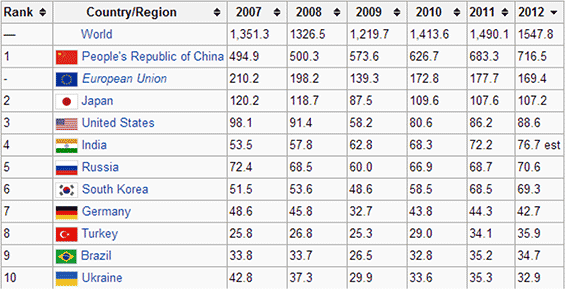Keeping an eye on CHINA. >> Morningstar
posted on
Sep 22, 2013 09:32PM

We may not make much money, but we sure have a lot of fun!

In 2009, the Chinese government embarked on one of the most aggressive fiscal stimulus measures in its history in fear that deflation would stall the economic growth trajectory, and in early 2013, with inflation at a dangerous 6 per cent-plus level, things were pared back.
For us, this is the most important piece of information in deciding where China goes in terms of growth.
When inflation ramps up and flows through to higher food prices (like pork in 2012), the government will become very sensitive to social concerns and seek to even out the cycle.
Food accounts for around 32 per cent of the Chinese inflation measurement, followed by residence costs at 17 per cent and transport at 10 per cent.
Combined, these three basic elements, which resonate so profoundly with the emerging lower and middle class, reflect almost 50 per cent of the inflation basket. When inflation goes up in China, the vast majority of the population feels the heat.
Why steel production matters
So, with inflation firmly in our mind, the other important data set we watch for is steel production numbers out of China. Put frankly, China is the largest steel factory in the world by a massive factor.
The chart below shows just how much steel China produces relative to the rest of the world. Since we cannot comprehend the size and scale of China's economy, trends in the pace of steel manufacturing do sometimes correlate very well with other industrial trends in the country.
Crude steel production (million tonnes)

Source: World Steel Association via wikipedia.org
As displayed above, China currently produces more than four times the total amount of steel produced in the entire European Union and more than six times the amount produced in Japan.
Five years ago, the ratio of difference was much smaller. Some estimates put the number of Chinese steel mills anywhere between 2600-2800.
China has a labour force of around 935 million people, of which around 770 million in 2012 were employed, according to statistics released by the Ministry of Health and Human Resources. Of this, around 30 per cent work in secondary industries like manufacturing, compared to 21 per cent back in 1990.
The steel manufacturing industry is crucial to Chinese employment and all other related industries. What happens in Chinese steel production will have a huge impact on where the Chinese economy goes and it therefore forms a crucial piece of the puzzle that we monitor.
We don't foresee the doomsday scenarios of China slashing its steel manufacturing industry and shedding millions of jobs because, to be frank, this will cause a huge amount of social disorder that will flow through to the rest of the economy.
China in a medium-term timeframe
As you can tell, we are bullish on China. Basically, as a quick reference guide, inflation and steel production are the numbers we watch. Our bullish view will not be shaken by short-term movements or news flow, but by what the Chinese central government is doing in terms of policy.
Beijing recently finalised plans for a Central Plains Economic Zone - a region that has traditionally served Northern China's agricultural belt and has been an important corridor for the transport of goods between rural and coastal economic centres.
The new zone will cover almost 300,000 square kilometres and encroach into Henan and neighbouring provinces.
The aim is to create a buffer to any social fallout in the moderating economic activity in the coastal hubs. As workers migrate back inland, the aim is to have the Central Plains regions be self-sufficient so workers can bring back their capital and skills with job prospects.
The Central Plains Economic Zone is expected to commence in 2015 and will by then be the largest single zone in terms of land mass and population. Perhaps the recent rally in iron-ore prices and steel manufacturing rates reflect the anticipation of these expansion measures.
The region also houses an enormous and relatively young population, which means it has a large potential labour force and decent consumer base.
We note this not because the Central Plains Economic Zone is likely to solve all of China's economic issues, but because it is an example of a new strategy to shift growth policies inwards.
The pipeline for future development opportunities like this is huge and will underpin a very long investment process in China, which in turn will require global commodities like iron ore.
There will be a timing gap between new projects like the Central Plains Economic Zone coming online and the 2009-led intensive construction boom phasing out.
But the market is finally starting to understand that China is not a one-trick pony and any investment view must have a medium-term horizon, with a close eye on inflation and steel production levels.